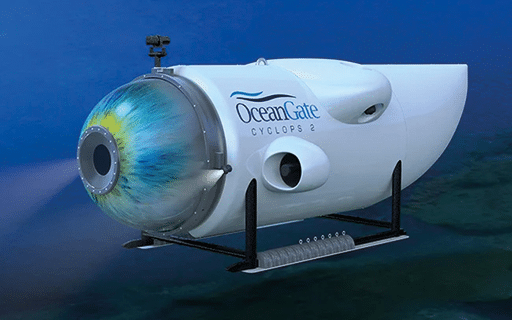As we go to press with this issue of Transport Security Intl., a small but highly technical submersible called OceanGate had gone missing as it was diving thousands of feet below the Atlantic Ocean in hopes of exploring the wreckage of the Titanic. It had been missing since Sunday June 18, which made Thursday morning, June 22 the deadline for finding the submersible and its passengers.
First, let me take a moment to acknowledge the humanity of this situation. On board the craft known as Titan, as we know now, are five people that include British businessman Hamish Harding, founder of Action Group and chairman of Action Aviation, an international aircraft brokerage company headquartered in Dubai, United Arab Emirates.
Also on board is Pakistani businessman Shahzada Dawood, 48, vice chairman of Pakistan’s Engro Corporation, and his teenage son, Suleman Dawood, aged 19. Suleman is a multimillionaire who had previously survived an aircraft incident that left he and his wife shaken, according to his wife’s blog.

French explorer Paul-Henri Nargeolet, 77, was reknowned for his “unparalleled” knowledge of the Titanic shipwreck and is said to have helped inspire his friend James Cameron’s 1997 movie Titanic. He had previously done as many as 37 dives to the wreckage site. He is director of underwater research for RMS Titanic, an American company that owns salvage rights to the wreck. It has been reported that his friends say he is an “extraordinary leader in crisis situations, and if anyone can keep those on board calm in the claustrophobic conditions on board the Titan, it’s him.”
And lastly, Stockton Rush is also on board. He is the CEO of the company that operates the OceanGate. He has been compared by some to Jacques Cousteau, a “nature lover, adventurer and visionary.”
It has been stated that each passenger paid about $250,000 or more for the extreme tourism experience to explore the wreck of the Titanic on the ocean floor, which is located about several hundred miles off the nearest coast — about 900 miles (1,450 km) east of Cape Cod, Massachusetts, and 400 miles (644 km) south of St John’s, Newfoundland.
These are real people and they are in a desperate situation. In no way do I want to diminish or sensationalize that. There is a great and overwhelming amount of coverage of this situation, and here’s hoping that the submersible, and all on board, are found alive and well and simply out of communication for some reason.
The trip to view the wreckage is supposed to take eight to 10 hours and the submersible is reported to have a 96-hour supply of oxygen for five people, four full days. As mentioned, Thursday morning as I write this is the key deadline date at which point the craft is said to run out of oxygen. Many factors would impact the amount of oxygen used, such as the temperature and rapid breathing due to a stressful situation. But perhaps there was also a safety margin added in that might allow for a bit of extra time.
Early on Wednesday morning, tapping sounds were detected by sonar in the search. “A Canadian P-3 aircraft detected underwater noises in the search area. As a result, ROV operations were relocated in an attempt to explore the origin of the noises. Those ROV searches have yielded negative results but continue,” a tweet from the Canadian Coast Guard said. “The data from the P-3 aircraft has been shared with our U.S. Navy experts for further analysis which will be considered in future search plans.” However, as of this writing, the tapping and the missing submersible could not be pinpointed.
Through all of the coverage, I have been thinking about other implications of this potentially tragic event and how it relates to security. U.S. and Canadian Coast Guard have searched an area larger than the state of Connecticut, more than 7,600 square miles of ocean, according to Jamie Frederick, a U.S. coast guard captain said at a press conference on Tuesday and the search was ongoing. Sonar buoys had been released to listen for the submersible. Additionally, a remotely-operated vehicle was also launched to search the area according to a tweet from the U.S. Coast Guard’s Northeast District. Aircraft are running a search grid in the skies above the area.
GPS and radar can scout out missing objects on Earth’s surface but are no match for the ocean, experts say. Water absorbs electromagnetic radiation, which is why sonar technology using sound waves is required. But even the sonar technology that rescuers are using to locate Titan is limited by depth.
There is also The Sound Surveillance System (SOSUS) which is a cold war-era array providing deep-water long-range detection capability in certain areas. SOSUS had success during the Cold War tracking submarines, according to the Federation of American Scientist’s (FAS) website. SOSUS consists of high-gain long fixed arrays in the deep ocean basins. After the Cold War became less of a concern, some of those devices were being placed in a standby status in which they are not continuously monitored. In the event of a resurgence in the global submarine threat the worldwide network of fixed undersea surveillance systems such as the Sound Surveillance System (SOSUS) would be a critical asset. Perhaps this is a good time to revisit the status of those arrays and think of upgrades?
Currently, the Integrated Undersea Surveillance System (IUSS) uses technological advancements in the Fixed Surveillance System (FSS), Fixed Distributed System (FDS), and the Advanced Deployable System (ADS). According to the FAS website, that program has undergone a major transition from emphasis on maintaining a large, dispersed surveillance force keyed to detection and tracking of Soviet submarines to a much smaller force that is effective against modern diesel and nuclear submarines in regional/littoral or broad ocean areas of interest. But what of using it to assist in this humanitarian effort?
In any case, it would seem logical that our current security surveillance systems should be able to assist in finding this lost submersible. Are they able? Do they already know the fate of the five? I cannot believe they would withhold that info when lives are at stake. And if the capability does not exist to assist, perhaps this is the nudge needed to upgrade for better security of our maritime environs.
UPDATE: As we went to press, it was reported that the U.S. Navy had heard, via a top secret acoustic detection system, the implosion that killed the five passengers hours after it began its descent to the Titanic wreck.
“The Navy began using the system, which is used to locate enemy submarines, to listen for the Titan almost immediately after it lost contact with its radio ship on Sunday,” a U.S. defense official told The Wall Street Journal. However, without the full certitude that what was heard was in fact the submersible imploding, the search went on to ensure that no stone was left unturned.
